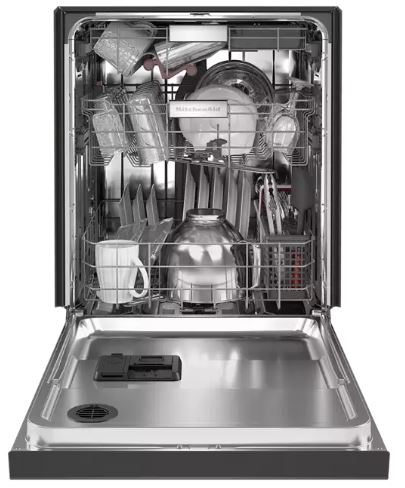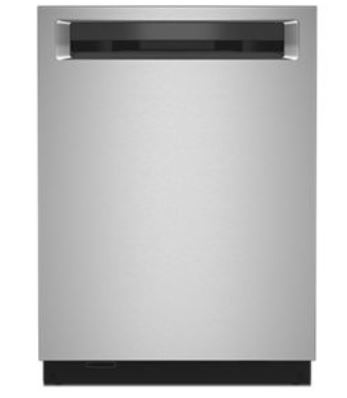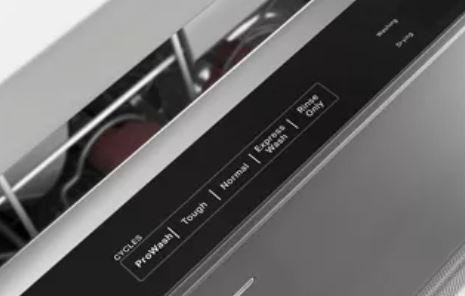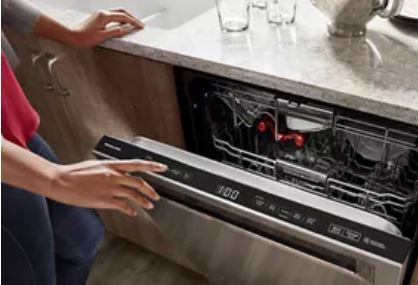Ordinarily, you expect a failed power supply to be why a dishwasher won’t start running. But what if your Kitchenaid dishwasher won’t start but has power? What should you check in such a case?
A Kitchenaid dishwasher won’t start even with power due to a programming hitch, wrong setting, unlatched door, failed water supply, non-responsive control panel or start button, or a defective component.
The components to consider for the last reason include the touchpad, timer, motor, and control board. If they fail, the dishwasher won’t start running even though it may power on. On that note, I’ll help you determine which issue relates to your dishwasher.
Moreover, we’ll look at a few other issues related to a non-starting Kitchenaid dishwasher and their causes. So, let’s dive in!

In a hurry? Below is a quick guide to fixing the seven issues that could stop a Kitchenaid dishwasher from starting even with a power supply.
Kitchenaid Dishwasher Won’t Start But Has Power – Quick Fixes
| – | Likely Cause | Quick Fix |
| 1. | Programming Hitch | Reset the dishwasher |
| 2. | Wrong Setting | Cancel any active Delay Wash, Sleep Mode, or Control Lock setting |
| 3. | Unlatched Door | Remove any obstruction on the door and replace a defective door switch or damaged door latch. |
| 4. | Failed Water Supply | Ensure the water supply valve is on, the inlet hose is free from kinks, and the inlet valve is clog-free |
| 5. | Non-responsive Control Panel | Clean and dry your hands before touching the control panel |
| 6. | Non-responsive Start Button | Free up the start button if it’s stuck, and replace it if it’s broken. |
| 7. | Defective Component | Replace a defective touchpad, timer, motor, or control board. |
7 Reasons Your Kitchenaid Dishwasher Won’t Start But Has Power
Besides failed power, at least seven other issues could stop a Kitchenaid dishwasher from starting. They include the following:
1. Programming Hitch
Occasionally, a Kitchenaid dishwasher experiences a programming hitch, where its settings freeze, preventing it from running. Overall, this is an issue you can fix with a power reset.
Fix
Power reset your Kitchenaid dishwasher by plugging it out for at least 1 minute. You can also turn it off from the circuit breaker (also for 1 minute).
2. Wrong Setting
If the reset doesn’t get your Kitchenaid dishwasher to run, it could be that the dishwasher is running on the wrong setting. Some of the settings that could prevent it from starting include:
- Delay Wash – This setting delays the dishwasher’s starting time until a pre-set time. So, the dishwasher doesn’t start immediately.
- Sleep Mode – This energy-saving mode stops the dishwasher from running. It just stays on standby.
- Control Lock – This safety feature renders the control panel inoperable. It aims to stop kids from operating the Kitchenaid dishwasher, and you must deactivate it to run it.
Fix
If any of the above settings are active, cancel them. You can cancel Delay Wash or Sleep Mode by pressing Cancel/Drain and then Start/Resume. However, you’ll need to hold down Control Lock for 3-4 seconds to turn it off.
3. Unlatched Door
Kitchenaid dishwashers quickly sense an open door; when they do, they may not start. So, check if that’s the case. The door might only be slightly open due to an obstruction. However, the door sometimes won’t latch because of a malfunctioning door switch or damaged door latch.
Fix
Check if something is obstructing the dishwasher door and remove it. If there’s none and the door won’t latch, check if the door latch is broken and replace it. If that’s not the case, inspect the door switch with a multimeter. If it lacks continuity, replace it.
4. Failed Water Supply
Your Kitchenaid dishwasher needs water just as much as it needs power. So, if it has power but lacks water, it won’t start. Overall, your Kitchenaid dishwasher won’t fill up with water due to:
- The water supply is off
- Kinked water inlet hose
- Clogged water inlet valve
Fix
First, ensure the water supply valve is turned on and straighten out the hose if there are kinks on the water inlet hose. Furthermore, clean any clog on the water inlet valve to allow water to flow smoothly.

5. Non-responsive Control Panel
The control panel is likely to be non-responsive if you touch it with a wet, dirty, or soapy hand. In such a case, the dishwasher won’t start when you press the start button on the control panel.
Fix
Avoid touching the control panel with wet, dirty, or soapy hands. If so, clean your hands and wipe them dry before touching the control panel.
6. Non-responsive Start Button
The issue could be the start button, which won’t engage the motor to run. In such a case, the start button could be stuck or damaged and thus non-responsive. In the first case, too much dirt could be around the start button, causing it to stick.
Fix
Clean around the start button to remove dirt obstruction, which could be causing it to stick. However, consider replacing the start switch if it’s broken or changing the entire control panel.
7. Defective Component
Lastly, your Kitchenaid dishwasher might not be starting even though there’s power because one of the components below is defective.
- Touchpad – Some buttons won’t be responsive if the touchpad is defective. So, you can touch all the buttons to see if some are responsive and others aren’t to determine if the touchpad is to blame.
- Timer – If the timer malfunctions, the control panel, the motor, and other critical components will get the wrong information. In the long run, the dishwasher won’t run.
- Motor – If the motor fails, the dishwasher won’t start. The motor has to run for the dishwasher to start a wash cycle and clean the dishes.
- Control board – If something is wrong with the main control board, no function will run, including the starting process. All internal components depend on the control board for direction, and if the control board is defective, the dishwasher will malfunction and may not start.
Fix
Consider replacing any of the above dishwasher components you perceive as faulty. A dishwasher expert can help you establish that if you can’t do it.
Kitchenaid Dishwasher Won’t Start No Lights
If your Kitchenaid dishwasher won’t start and has no lights, it highly points to a power issue. In that case, watch out for any of these signs:
- Power outage
- An unplugged or wobbly power cord
- Defective socket
- Defective power cord
- Tripped circuit breaker
- Blown-up thermal fuse
Note, however, that besides the lack of power, a Kitchenaid dishwasher may fail to start or light up due to a dead main control board. So, consider that after ruling out failed power.

Kitchenaid Dishwasher Won’t Start Wash Cycle
Your Kitchenaid dishwasher won’t start the wash cycle for different reasons. First, it could be that the dishwasher lacks power or adequate water supply.
Second, it could be a wrong setting, such as a Control Lock, Delay Wash, Sleep Mode, or a programming hitch fixable with a power reset.
Other issues include dish overload, an unlatched door, failed drainage, and a non-responsive control panel or start switch.
Kitchenaid Dishwasher Won’t Start Lights Blinking
If your Kitchenaid dishwasher is blinking but not starting, check if the cycle has been interrupted. In that case, check for an open door, failed water supply, or power disruption. But if it’s not an interrupted cycle, it’s likely to be a defective water inlet valve, which you ought to replace.
Kitchenaid Dishwasher Won’t Start Clean Light Blinking
A flashing clean light is ideally an error code. The Kitchenaid dishwasher is trying to communicate a fault to you. More often than not, it’s a water temperature fault. It shows that your dishwasher is having difficulty heating the water.
Overall, you can try to reset the dishwasher to fix the error codes as follows:
- Locate High Temp Wash and Heated Dry switches and press them four times, each one after the other, to reset the control board
- Press cancel Drain and wait to select a new cycle
- Press start to run the new cycle
Replacing the dishwasher’s main control board may be ideal if the reset doesn’t work. But before you do, have a dishwasher expert examine it.
Kitchenaid Dishwasher Won’t Start Just Beeps
Just like the blinking light, a beeping sound is a fault code. In most cases, the Kitchenaid dishwasher beeps when you interrupt the cycle, and in that case, check for a partially latched door and ensure you press start/resume after you firmly shut the door.
But still, the dishwasher may beep and fail to start due to insufficient detergent, dish overload, disconnected water, and power fluctuation. Also, expect it to beep when you pick the wrong setting, such as Delayed Wash, Control Lock, or Sleep Mode.

People Also Ask
1. How Do I Reset My Kitchenaid Dishwasher Not Starting?
You can reset your Kitchenaid dishwasher when it doesn’t start by disconnecting it from the power source for at least 60 seconds. After that, you can power the dishwasher to see if it’ll start running.
2. What Buttons Do I Push To Reset My Kitchenaid Dishwasher?
While the easiest way to reset the Kitchenaid dishwasher is to plug it out for at least 60 seconds, you can also do it by pressing several buttons. First, press High-Temp wash + Heated Dry 4 times each, one after the other. Then press Cancel/Drain and wait a few seconds to run a New Cycle.
3. How Do You Get A Kitchenaid Dishwasher To Start?
You can get a Kitchenaid dishwasher to start using these steps:
- Ensure the dishwasher has power (it should turn on)
- Ensure the dishwasher receives water
- Confirm that the dishwasher setting is okay – deactivate Control Lock, Delayed Wash, or Sleep Mode
- Don’t touch the dishwasher control panel with wet, soapy, or dirty hands
- Ensure the dishwasher door latches properly
- Replace a defective touchpad or start switch
Concluding Thought:
Now you know the seven issues to check and fix when the Kitchenaid dishwasher won’t start but has power. It begins with resetting the dishwasher in case of a programming hitch and ensuring the setting is correct, the door is latched correctly, and the dishwasher gets water.
Then, ensure the control panel and start button are responsive, and if the touchpad, timer, motor, or main control board is defective, replace it.
Also Read:
